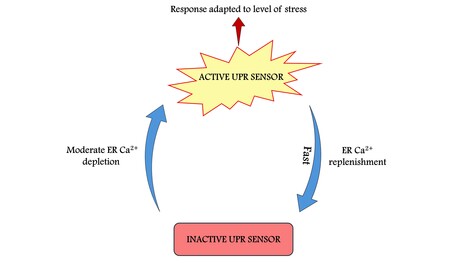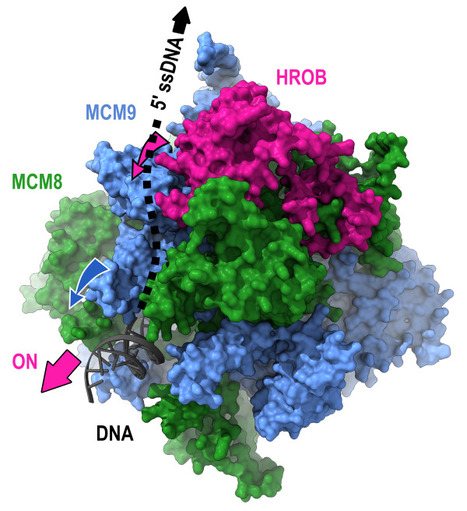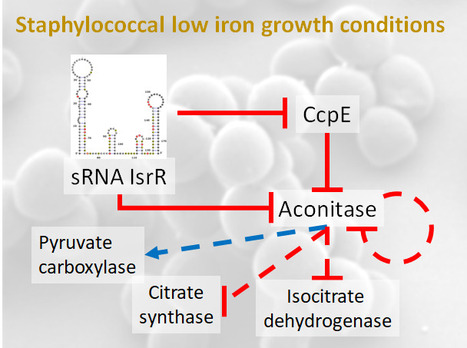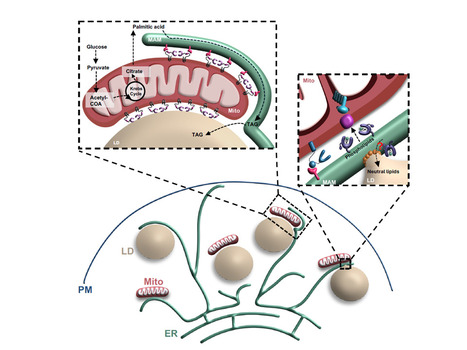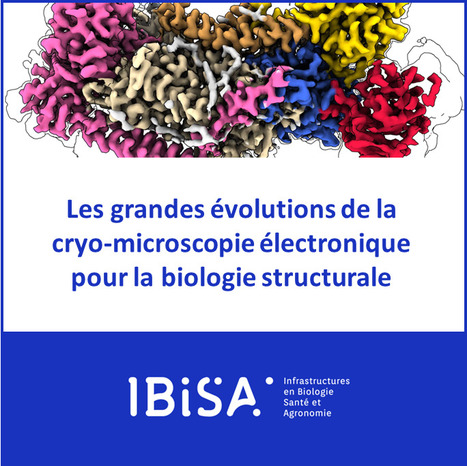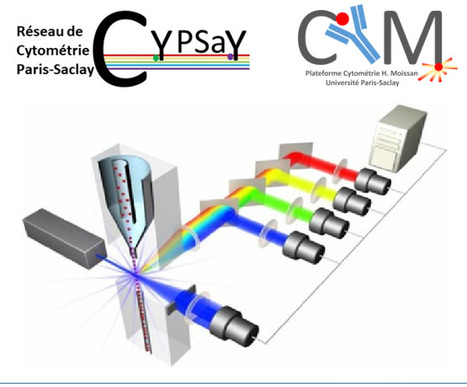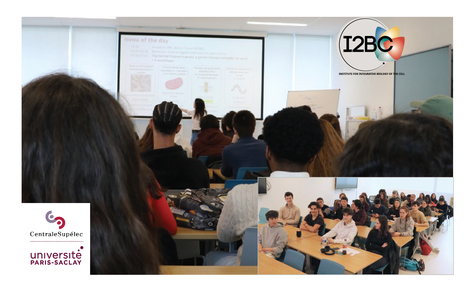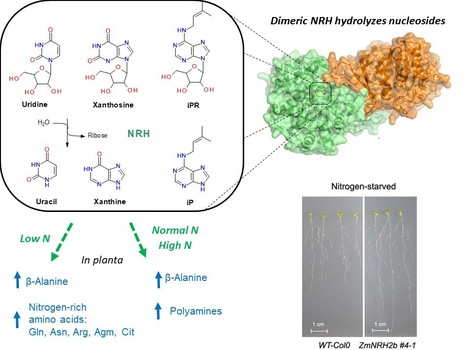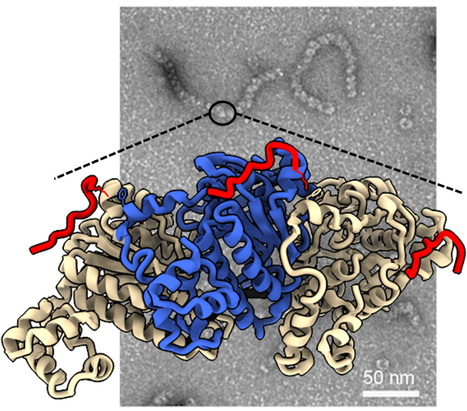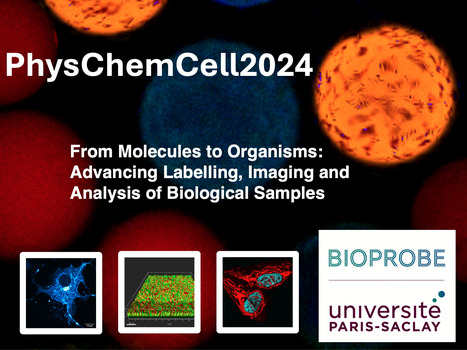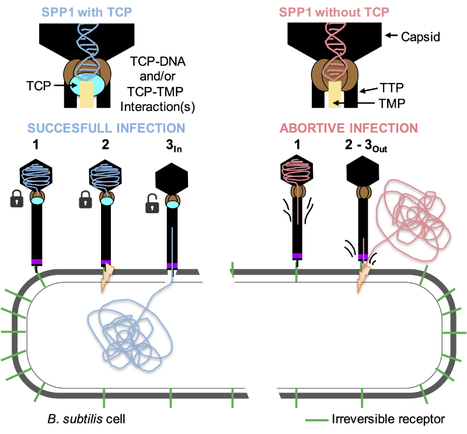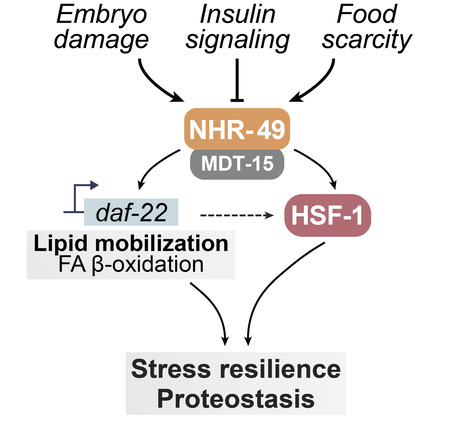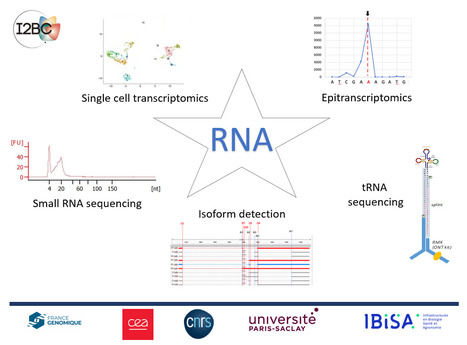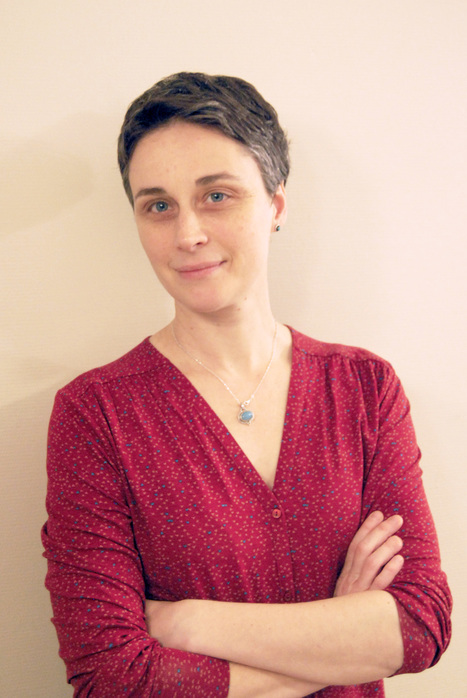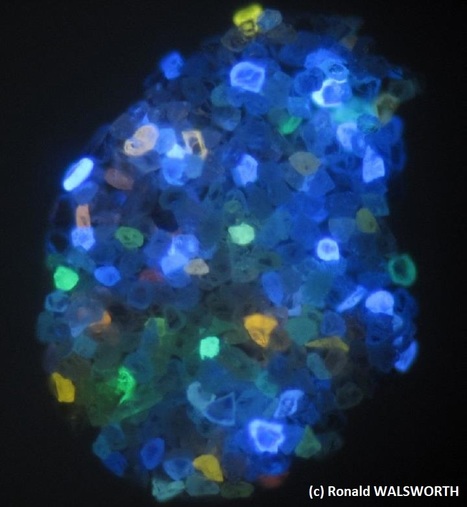 Your new post is loading...
 Your new post is loading...

|
Scooped by
I2BC Paris-Saclay
July 26, 9:11 AM
|
A tumor suppressor that generates subnucleosomes
Researchers from the I2BC, the CNRGH (CEA, National Center of Human Genomics Research), and the University of Edinburgh have revealed how the BAF chromatin remodeler changes the structure and accessibility of genetic material by producing subnucleosomal particles. These findings are published in Nature Structural and Molecular Biology. Mutations in genes encoding subunits of the BAF complex (BRG1/BRM-associated factors, also known as the SWI/SNF complex) are associated with 20% of human cancers, making this complex the second most frequently mutated factor after the p53 tumor suppressor.
The human genome exists in cells in the form of chromatin, composed of nucleosomes that condense and protect the genetic material. The nucleosomes represent a physical barrier for transcription factors and molecular machinery that regulate gene expression. The BAF complex is known for controlling chromatin opening at gene transcription regulatory elements. Until now, it was believed that the role of the BAF complex was to dissociate the nucleosomes to allow the transcription factors to access DNA.
Using a method that allows them to differentiate histone-free DNA fragments from nucleosomes and histone-containing particles smaller than nucleosomes (subnucleosomes), researchers coordinated by Matthieu Gérard (I2BC) revealed that the BAF complex facilitates the recruitment of the master transcription factor OCT4 using two distinct strategies: i) by generating the well-known histone-free DNA regions, which OCT4 binds if its target DNA motif is present; and ii) by producing a new class of subnucleosomal particles containing 50 to 80 base pairs associated with histones.
They show that the subnucleosomes act as a recruitment platform for OCT4 independently of the presence of its DNA motif. They identify in this publication a molecular mechanism in which the interaction between OCT4 and the subnucleosomes leads to a spectacular expansion of the OCT4 genomic binding interval. This mechanism aims to project OCT4 activity in chromatin opening within a genomic interval up to one order of magnitude larger than the interval bound by OCT4 on histone-free DNA.
This study suggests two main determinants for recruiting transcription factors onto the mammalian genome: the genetic determinant, the transcription factor motif within histone-free DNA, and an epigenetic determinant, which corresponds to the subnucleosomes produced by the BAF complex. More information: https://www.nature.com/articles/s41594-024-01344-0 Contact: Matthieu GERARD matthieu.gerard@i2bc.paris-saclay.fr

|
Scooped by
I2BC Paris-Saclay
July 26, 8:21 AM
|
SYNTERUPTOR : mining genomic islands for non-classical specialized metabolite gene clusters
In search of the hidden gene cluster: Synteruptor, a new tool for identifying bacterial genomic islands and exploring their content in the quest for new specialized metabolism gene clusters. Microbial specialized metabolite biosynthetic gene clusters (SMBGCs) are a formidable source of natural products of pharmaceutical interest. With the multiplication of genomic data available, very efficient bioinformatic tools for automatic SMBGC detection have been developed. Nevertheless, most of these tools identify SMBGCs based on sequence similarity with enzymes typically involved in specialised metabolism and thus may miss SMBGCs coding for undercharacterised enzymes. In this article, we present Synteruptor (https://bioi2.i2bc.paris-saclay.fr/synteruptor), a program that identifies genomic islands, known to be enriched in SMBGCs, in the genomes of closely related species. With this tool, we identified a SMBGC in the genome of Streptomyces ambofaciens ATCC23877, undetected by antiSMASH, the well-known and most used tool for SMBGC identification, prior to antiSMASH 5. We experimentally demonstrated that this SMBGC directs the biosynthesis of two metabolites, one of which was identified as sphydrofuran. Synteruptor is also a valuable resource for the delineation of individual SMBGCs within antiSMASH regions that may encompass multiple clusters, and for refining the boundaries of these SMBGCs. More information: https://doi.org/10.1093/nargab/lqae069 Contact: Sylvie LAUTRU <sylvie.lautru@i2bc.paris-saclay.fr> & Olivier LESPINET <olivier.lespinet@i2bc.paris-saclay.fr>

|
Scooped by
I2BC Paris-Saclay
July 26, 8:14 AM
|
Gradual ER calcium depletion induces a progressive and reversible UPR signaling
The UPR sensors show high plasticity in sensing physiological alterations by closely reporting the variations in ER Ca2+ levels. Through this mechanisms cells could rapidly adapt stress response signaling pathways to variations in ER homeostasis. The unfolded protein response (UPR) is a widespread signal transduction pathway triggered by endoplasmic reticulum (ER) stress. Because calcium (Ca2+) is a key factor in the maintenance of ER homeostasis, massive Ca2+ depletion of the ER is a potent inducer of ER stress. Although moderate changes in ER Ca2+ drive the ubiquitous Ca2+ signaling pathways, a possible incremental relationship between UPR activation and Ca2+ changes has yet to be described. Here, we determine the sensitivity and time-dependency of activation of the three ER stress sensors, IRE1α, PERK and ATF6α in response to controlled changes in the concentration of ER Ca2+ in human cultured cells. Combining Ca2+ imaging, FRAP experiments, biochemical analyses and mathematical modeling, we uncover a non-linear rate of activation of the IRE1α branch of UPR, as compared to the PERK and ATF6α branches that become activated gradually with time and are sensitive to more important ER Ca2+ depletions. However, the three arms are all activated within a 1h timescale. The model predicted the deactivation of PERK and IRE1α upon refilling the ER with Ca2+. Accordingly, we showed that ER Ca2+ replenishment leads to the complete reversion of IRE1α and PERK phosphorylation in less than 15 min, thus revealing the highly plastic character of the activation of the upstream UPR sensors. In conclusion, our results reveal a dynamic and dose-sensitive Ca2+-dependent activation/deactivation cycle of UPR induction, which could tightly control cell fate upon acute and/or chronic stress. More information: https://doi.org/10.1093/pnasnexus/pgae229 Contact: Ilaria Pontisso (ilaria.pontisso@i2bc.paris-saclay.fr)

|
Scooped by
I2BC Paris-Saclay
July 3, 8:32 AM
|
PhD Position in Immuno-Virology at Paris-Saclay University
We are seeking one highly motivated PhD candidate to join our research team at the Institute for Integrative Biology of the Cell (I2BC). The project entitled “Selective autophagy receptors in viral antigen presentation” is an exciting opportunity to explore the intersection
of immunology and virology. More information: https://www.i2bc.paris-saclay.fr/equipe-autophagy-and-antiviral-immunity/ Contact: Arnaud Moris (arnaud.moris@i2bc.paris-saclay.fr)

|
Scooped by
I2BC Paris-Saclay
July 2, 10:31 AM
|
Mechanism of DNA unwinding by MCM8-9 in complex with HROB
Researchers from the AMIG team (I2BC department), in collaboration with the IRB (Switzerland), have modeled the interaction between HROB and the helicases MCM8-MCM9, some mutations of which predispose individuals to infertility or cancer. They demonstrate that HROB promotes the catalytic activity of the MCM8-MCM9 complex but does not play a role in its recruitment or stability. The proteins MCM8 and MCM9 have recently been discovered as involved in multiple processes, normal and pathological, related to DNA replication, meiosis, homologous recombination, and mismatch repair. These proteins are helicases that have the ability to move along DNA and separate the two DNA strands. Variants of these proteins may predispose carriers to disorders such as infertility and cancer. In 2019, a third partner, HROB, was identified as associated with these two helicases without its mechanisms of action being understood. Since HROB is capable of interacting with DNA, three functional hypotheses can be considered:
1) HROB participates in the recruitment of helicases on DNA,
2) HROB stabilizes the assembly of MCM8 and MCM9 on DNA,
3) HROB promotes the catalytic activity of pre-assembled helicases. In a study published in the journal Nature Communications, researchers from the AMIG team at the Institute of Integrative Biology of the Cell (I2BC) collaborated with a team from the Institute of Research in Biomedicine (IRB) in Switzerland to establish different structural models of the MCM8-MCM9-HROB complex. Guided by these models, a set of simple and compensatory mutations allowed the dissection of the functional role of HROB. The teams showed that only the third hypothesis was correct and that HROB is an essential factor for activating the MCM8-MCM9 helicase but not for its recruitment or stability. The structural model suggests that by transiently altering the conformation of a MCM9 subunit, HROB stimulates the translocation of the helicase along the DNA. Based on this model, it was even possible to design mutations that increase the efficiency of the helicase in the presence of HROB. More information: https://www.nature.com/articles/s41467-024-47936-8 Contact: Raphaël Guerois raphael.guerois@i2bc.paris-saclay.fr

|
Scooped by
I2BC Paris-Saclay
July 2, 10:27 AM
|
Staphylococcus aureus in the battle for iron: three post-transcriptional regulations at work
A feed-forward loop controlled by the regulatory sRNA IsrR and the aconitase moonlighting activity prevent aconitase production during iron deficiency. Staphylococcus aureus, responsible for nosocomial infections and septicemia, is the leading cause of bacterial mortality in most countries of the world. Its pathogenicity relies on its adaptation to a wide range of biotopes.
As iron bioavailability is sometimes a limiting factor for growth, bacteria have developed strategies to scavenge iron and reduce its utilization under iron-depleted growth conditions. One such strategy involves the modulation of iron-utilizing proteins through the action of non-coding regulatory RNAs (sRNA). Notably, our previous research unveiled the significance of IsrR, a staphylococcal sRNA required for optimal growth in iron-depleted media and sustaining full virulence (Coronel-Tellez, 2022). Triggered by iron starvation, IsrR coordinates the down-regulation of genes encoding [Fe-S]-containing enzymes, including aconitase.
Aconitase converts citrate to isocitrate. CcpE, a citrate-activated transcriptional regulator, positively regulates its gene. In this new work, we show that IsrR inhibits the translation of aconitase mRNA and of ccpE mRNA, thus establishing a coherent feed-forward regulatory loop. This dual mechanism of repression ensures effective control of aconitase production by IsrR. Aconitase is a protein known for its second (moonlighting) activity in the absence of its [Fe-S] cluster; it becomes an RNA-binding protein (RBP) with regulatory capacity. This characteristic is conserved from prokaryotes to eukaryotes. Here, we show that the RBP activity of S. aureus aconitase reduces the amount of aconitase and influences the expression of genes encoding metabolic enzymes during iron deficiency.
Our study reveals the complex network of post-transcriptional regulations governing aconitase production that enables S. aureus to thrive in iron-deficient conditions. Importantly, these conditions are encountered by bacteria in the host as a result of a defense response known as nutritional immunity, in which iron and other essential nutrients are sequestered to prevent infection. More information: https://academic.oup.com/nar/advance-article/doi/10.1093/nar/gkae506/7692338 Contact: Philippe Bouloc philippe.bouloc@i2bc.paris-saclay.fr

|
Scooped by
I2BC Paris-Saclay
July 1, 8:59 AM
|
“Ménage à trois”: emerging function of the mitochondria-ER-lipid droplet connection in coordinating lipid transfer, metabolism and storage in cells
“Ménage à trois”: coordination of lipid transfer, metabolism and storage at the new mitochondria-ER-lipid droplet junction. Over the past two decades, we have witnessed a growing appreciation for the importance of membrane contact sites (CS) in facilitating direct communication between organelles. CS are tiny regions where the membranes of two organelles meet but do not fuse and allow the transfer of metabolites between organelles, playing crucial roles in the coordination of cellular metabolic activities. The significant advancements in imaging techniques, and molecular and cell biology research has revealed that CS are more complex than what originally thought, as they are extremely dynamics, they can remodel their shape, composition and functions in accord to metabolic and environmental changes, and can occur between more than two organelles. In this review, for the Special Issue “Lipid droplets, metabolic hubs in health and disease“ in FEBS Letters, Vera F. Monteiro-Cardoso and Francesca Giordano describe how recent studies led to the identification of a three-way mitochondria-ER-lipid droplet CS and discuss the emerging functions of these contacts in maintaining lipid storage, homeostasis and balance. They also summarize properties and functions of key protein components localized at the mitochondria-ER-lipid droplet interface, with a special focus on lipid transfer proteins. Understanding tripartite CS is essential for unraveling the complexities of inter-organelle communication and cooperation within cells. more information: https://febs.onlinelibrary.wiley.com/doi/10.1002/1873-3468.14893 contact: Francesca GIORDANO <francesca.giordano@i2bc.paris-saclay.fr>
Les grandes évolutions de la cryo-microscopie électronique. En l’espace d’une décennie, cette méthode d’observation ultraprécise n’a eu de cesse d’être perfectionnée. Co-responsable de la plateforme Biostruct@UPSAY, Stéphane Bressanelli explique le bénéfice de ces améliorations dans le domaine de la biologie structurale. Lire l’article. IBiSA est dans le Microscopoly ! A l’occasion de ses 20 ans, le réseau technologique de microscopie photonique de fluorescence multidimensionnelle (RTmfm) lance la version microscopie du Monopoly ! IBiSA se trouve sur le plateau, aux côtés de nombreuses plateformes labellisées. L’empreinte carbone, c’est aussi une affaire de plateformes. Les plateformes sont-elles obligées de réaliser un bilan carbone ? Que faut-il prendre en compte ? Tête-à-tête avec Floriant Bellvert, ingénieur sur la plateforme MetaToul et intervenant sur les ateliers de formation IBiSA axés empreinte environnementale de la recherche. Lire l'article. Quels outils pour la gestion de projets sur les plateformes ? La gestion de projets est facilitée par une multitude de logiciels. Comment choisir et adapter les outils aux plateformes ? Exemples de solutions originales présentées par des ingénieurs de plateformes au cours des ateliers de formation IBiSA. Lire l'article. Vous souhaitez recevoir la newsletter publiée par IBiSA chaque trimestre ? Inscrivez-vous ! A propos d’IBISA. Le GIS IBiSA coordonne la politique nationale de labellisation et de soutien aux infrastructures de biologie, santé et agronomie. Placé sous la tutelle de 8 partenaires, il est l’unique instrument de financement commun à l’ensemble des établissements de recherche en sciences du vivant. Grâce à deux appels d’offres dédiés, les plateformes et centres de ressources biologiques (CRB) peuvent candidater à la labellisation IBiSA et accéder à des financements conséquents pour des investissements jugés nécessaires à leurs missions. Le GIS conditionne son soutien à une ouverture large à la communauté scientifique. Il encourage également la création de structures de pilotage, concertation et coopération, l'animation de réseaux thématiques et les démarches qualité. Vous souhaitez découvrir le potentiel de Paris-Saclay en termes de plateformes ? L’interface Plug In Labs Université Paris-Saclay recense et rend visible plus de 200 plateformes dans le domaine des sciences de la vie - des plateaux techniques, des plateformes technologiques, des infrastructures d’expérimentation, mais aussi des collections - en d’autres termes, des espaces de laboratoires dotés d’équipements, souvent uniques, ou de banques de ressources, associés à un fort potentiel humain, les opérant et les maintenant au meilleur niveau technologique. A propos de Plug In Labs Université Paris-Saclay. Plug In Labs Université Paris-Saclay ou PILUPS pour les intimes, est le portail numérique unique retenu par l’Université Paris-Saclay pour la mise en valeur et promotions des compétences, expertises et technologies des laboratoires et plateformes technologiques de son territoire. Piloté par l’Université Paris-Saclay et la SATT Paris-Saclay, financé par l’IDEX et le Fonds national de valorisation, PILUPS est accessible à tous depuis 2017, partenaires académiques comme entreprises, en particulier les PME. Un seul site web : https://www.pluginlabs-universiteparissaclay.fr. Et une seule adresse mail : pluginlabs@universite-paris-saclay.fr.
Via Life Sciences UPSaclay
Suite à son installation à Henri Moissan en juillet 2022, la plateforme de cytométrie en flux PLAIMMO de l'Unité Mixte de Service "Ingénierie et Plateformes au Service de l'Innovation Thérapeutique"(UMS-IPSIT) est devenue CYM (Cytométrie Henri Moissan). Le personnel de la plateforme, accompagné par sa référente scientifique, le Pr Géraldine Schlecht, a relancé ses activités pour vous accompagner dans la réalisation de projets de recherche fondamentale ou préclinique, ainsi que dans la mise en place de protocoles de recherche clinique nécessitant l'utilisation d'un cytomètre. Après l’installation des laboratoires, l’objectif premier a été de dynamiser et faire découvrir les possibilités de la cytométrie au sein de l’Université Paris-Saclay. Marie-Laure Aknin, responsable de la plateforme CYM, a sollicité l’ensemble des plateformes de l’écosystème de l’Université Paris-Saclay dans l’objectif de créer un réseau de cytométrie de proximité. La dynamique très positive, apparue dès les premières réunions, a permis de choisir collégialement le nom de ce réseau d’experts, baptisé CyPSay (Cytométrie Paris-Saclay). Ce réseau, créé tout début 2023, regroupe à ce jour 8 plateformes : CYM (ex PLAIMMO, IPSIT / Plateforme de Cytométrie H. Moissan), SpICy (ICP / SpectroImageries et Cytométrie), FlowCyTech (IDMIT, Institut JACOB) et I2BC / Plateforme de cytométrie (IMAGERIE-GIF) d’une part, ensemble qui vient compléter le réseau des plateformes présent sur le biocluster GENOPOLE nommé OCCIGEN. Ce réseau génopolitain regroupe les équipements complémentaires présents sur ImCy (Imagerie-Cytométrie, GENETHON), sur la plateforme de bioproduction (cellulaire, automatisée) de l’I-Stem, au LGRK (Laboratoire de Génomique et Radiobiologie de la Kératinopoïèse, Institut JACOB) et sur la plateforme de tri et clonage de levures opérée par Hybrigenics Services. Le réseau recense aujourd’hui une vingtaine d’équipements dont une quinzaine d’analyseurs : Fortessa (BD Biosciences) ; cytoFLEX S et cytoFLEX LX (Beckman Coulter) ; Partec (Sysmex) ; NovoCyte 3000 (Agilent), MACS Quant 10 et MACS Quant X (Miltenyi) ; SP6800 (Sony), très souvent situés à proximité de trieurs : SH800 (Sony) ; ARIA IIu et ARIA Fusion (BD Biosciences) ; MoFlo AstriosEQ et cytoFLEX SRT (Beckman Coulter). L’objectif du réseau est de partager les expertises respectives des partenaires à travers des réunions régulières, de discuter des évolutions des technologies pour acquérir et analyser des données de cytométrie, d’identifier les besoins en investissements et de se fédérer pour des demandes de financement d’instruments et/ou de logiciels spécifiques. A travers ce Focus Plateforme, nous souhaitons rendre encore plus visible ce réseau proposant un accompagnement optimal de tous vos projets en cytométrie et promouvoir la découverte de cette technologie à travers différentes journées de formation ou séminaires ouvertes à tous. Le réseau a organisé une première journée de formation de cytométrie en flux le 26 octobre dernier à Henri Moissan. Cette journée a été l’occasion de présenter les différentes plateformes du réseau puis de proposer une formation théorique sur les bases de la cytométrie, réalisée par Mr Jean-Baptiste Guillerme de la société Biolegend. Cette journée fut une belle réussite avec environ 40 participants. L’enquête de satisfaction a démontré un bon niveau de satisfaction. Le réseau CyPSay travaille déjà à l’organisation d’une deuxième journée, à laquelle vous serez prochainement invités. Nous espérons vous y retrouver très nombreux ! Pour tout renseignement complémentaire, n'hésitez pas à contacter la plateforme du réseau CyPSay la plus proche. Contact : Marie-Laure Aknin (marie-laure.aknin@universite-paris-saclay.fr) Plug In Labs Université Paris-Saclay : cliquer ICI Aussi, la plateforme a déjà publié trois FOCUS PLATEFORME, n’hésitez-pas à les relire … IPSIT / Plateforme de Cytométrie H.Moissan (CYM). La plateforme de cytométrie en flux (CYM) de l'Unité Mixte de Service, Ingénierie et Plateformes au Service de l'Innovation Thérapeutique (UMS-IPSIT), située au rez-de-chaussée du bâtiment Recherche Henri Moissan (HM1) offre régulièrement ses services aux équipes de recherche académiques du territoire Paris-Saclay ainsi qu'aux industriels. Le personnel de la plateforme est à votre disposition pour vous aider à la réalisation de projets de recherche fondamentale, préclinique sur des modèles expérimentaux ainsi que pour des protocoles de recherche clinique. Son personnel est aussi à votre service pour la mise au point de nouvelles techniques utilisant la cytométrie en flux. Les équipements de cytométrie en flux de la plateforme permettent le phénotypage des cellules par la détection de molécules membranaires et intracellulaires (biomarqueurs) mais aussi des études fonctionnelles telles que la détection de phosphorylation des protéines, la prolifération cellulaire, la quantification de cytokines ou chimiokines excrétées ou la détection d'ARN. Enfin, des tris cellulaires à haut débit sont aussi proposés par la plateforme. Nos activités qui peuvent être en relations avec celle d'autre plateforme, permettent l'identification de nouveaux biomarqueurs pouvant être des cibles thérapeutiques. A propos d’IPSIT. IPSIT (Ingénierie et Plateformes au Service de l’Innovation Thérapeutique) est une Unité Mixte de Service placée sous les tutelles conjointes de l’UPSaclay (UMS-IPSIT), l’Inserm (US31) et le CNRS (UAR3679). L’IPSIT regroupe 11 plateformes techniques, organisées en trois pôles technologiques (IMCELLF, OMICS et INTERACTIONS) et trois plateformes transverses. L’IPSIT se veut résolument à l’interface de la chimie, de la biologie et de la clinique en établissant le lien entre la cible pathologique et le médicament. L’IPSIT est adossée à une Structure Fédérative de Recherche (SFR) qui rassemble l’UMS-et 25 équipes de recherche. Enfin, IPSIT participe à l’animation scientifique et à la formation des étudiants et des personnels tout en contribuant au rapprochement d’équipes d’horizons différents et à la transdisciplinarité des collaborations. Voir aussi leur FOCUS PLATEFORME décrivant toutes leurs expertises !
Via Life Sciences UPSaclay
Les bactériophages sont des virus qui infectent les bactéries et sont considérés comme les entités vivantes les plus abondantes sur la Terre. Plusieurs enseignants-chercheurs appartenant à l’Institut de Biologie Intégrative de la Cellule - I2BC (CNRS/CEA/UPSaclay, Gif-sur-Yvette) se sont associés afin de découvrir de nouveaux phages infectant la bactérie Corynebacterium glutamicum, organisme essentiel pour la production mondiale de glutamate. Seuls six phages de C. glutamicum ont été caractérisés jusqu’à présent. Dans le cadre des enseignements de licence de biologie à l’université Paris-Saclay, des prélèvements de sols et d’eau ont été réalisés par douze étudiants de 2ème année. Le phage PSonyx, capable d’infecter C. glutamicum, a ainsi été purifié à partir du bassin de la Tuilerie à Massy. A l’aide du microscope électronique de l’I2BC, les étudiants ont observé que la particule virale était un phage caudé avec une queue flexible. Le matériel génétique qu’ils ont purifié a été séquencé grâce au programme de coopération universitaire international SEA-PHAGES (Science Education Alliance- Phage Hunters Advancing Genomics and Evolutionary Science). Ensuite, 21 étudiants de 3ème année ont pris le relais pour analyser le génome de 80 kb. Les deux tiers des 141 gènes échappent à toute prédiction fonctionnelle et représentent un réservoir de fonctions antibactériennes à haut potentiel en biotechnologies. Les résultats de ces enseignements innovants ont été publiés dans Microbiology Resource Announcements. Les 33 étudiants impliqués dans le projet font partie des auteurs de l’article : un tremplin important pour ces étudiants de licence vers la recherche ! Contact : ombeline.rossier@universite-paris-saclay.fr ou christophe.regeard@universite-paris-saclay.fr
Via Life Sciences UPSaclay

|
Scooped by
I2BC Paris-Saclay
May 15, 5:27 AM
|
Imprinting gene regulation: Importance of a long non-coding RNA and of DNA methylation levels at an essential CTCF binding site
The Dlk1-Meg3-Dio3 domain is imprinted. Scientists at the IGMM and the I2BC have determined that Meg3 long non-coding RNA, as well as DNA methylation levels at an essential CTCF binding site in the domain, control Dlk1 imprinting in cis. The imprinted Dlk1-Dio3 domain comprises the Dlk1 and Rtl1 developmental genes that are solely expressed from the paternal chromosome, and a maternally-expressed polycistron that is further processed into the Meg3 long non-coding RNA (lncRNA) and many other small non-coding RNAs. In collaborative work between scientists at the IGMM (R. Feil’s group; Montpellier) and at the I2BC (D. Noordermeer’s group; Gif-sur-Yvette), researchers studied the precise role of Meg3 lncRNA and of its promoter for the control of Dlk1 and Rtl1 imprinted gene expression. Using mutant cells with either premature termination of transcription or deletion of part of the polycistron, they found that Meg3 lncRNA, but not other non-coding RNAs produced by the polycistron, controls Dlk1 imprinting in cis. The maternal expression of this polycistron is driven by the Meg3 differentially methylated region (Meg3-DMR) which is unmethylated on the maternal allele and acts there as an active promoter. Besides, the Meg3-DMR includes a known binding site for the architectural CTCF protein, that binds to the unmethylated maternal allele only. In this study, the researcher showed that the maternal Dlk1-Dio3 locus is organized into sub-Topologically Associating domains (sub-TADs) that are hinged by the allelic binding of CTCF to the maternal Meg3-DMR. They further found that the methylation levels at the Meg3-DMR are instructive for CTCF binding and thereby dictate distinctive sub-TAD organization at the two parental alleles which, in turns, facilitates Dlk1 repression on the maternal allele. Altogether, this collaborative work revealed that, the maternally-expressed Meg3 lncRNA controls Dlk1 silencing in cis, and that the low methylation levels at the maternal Meg3-DMR allows for specific sub-TADs structuration that concurrently contributes to Dlk1 silencing. More information: https://academic.oup.com/nar/advance-article/doi/10.1093/nar/gkae247/7645245?searchresult=1 Contact: Benoit Moindrot benoit.moindrot@i2bc.paris-saclay.fr

|
Scooped by
I2BC Paris-Saclay
April 15, 9:18 AM
|
Students from CentraleSupélec visit I2BC groups of the Cellular Biology department
80 students of the Bachelor of Global Engineering, a joint novel program of CentraleSupéléc and McGilles University visited the research groups Kühl, Sala and Siudeja at the Cellular Biology department at I2BC in March. During two afternoons in March three groups from the Cellular Biology department, Kühl, Sala and Siudeja, explained their research questions and model organisms to a total of 80 students from the Bachelor of Global Engineering (BoGe), a joint novel program of CentraleSupéléc, Paris-Saclay and McGilles University, Canada (https://www.centralesupelec.fr/en/bachelor-global-engineering) . The visit was part of the BoGe Biology course taught by Sébastien Bloyer (Genome dep.) and Inge Kühl (BioCell dep.). We thank all the participants for their help, and the I2BC for the support.

|
Scooped by
I2BC Paris-Saclay
April 15, 9:03 AM
|
Plant nucleoside N-ribohydrolases: riboside binding and role in nitrogen storage mobilization
Plants can benefit from fast nucleoside breakdown Cells save their energy during nitrogen starvation by selective autophagy of ribosomes and degradation of RNA to ribonucleotides and nucleosides. Nucleosides are hydrolyzed by nucleoside N-ribohydrolases (nucleosidases, NRHs). Subclass I of NRHs preferentially hydrolyzes the purine ribosides while subclass II is more active towards uridine and xanthosine. Here, we performed a crystallographic and kinetic study to shed light on nucleoside preferences among plant NRHs followed by in vivo metabolomic and phenotyping analyses to reveal the consequences of enhanced nucleoside break-down. We report the crystal structure of Zea mays NRH2b (subclass II) and NRH3 (subclass I) in complexes with the substrate analog forodesine. Purine and pyrimidine catabolism are inseparable because nucleobase binding in the active site of ZmNRH is mediated via a water network and is thus unspecific. Dexamethasone-inducible ZmNRH overexpressor lines of Arabidopsis thaliana, as well as double nrh knockout lines of moss Physcomitrium patents, reveal a fine control of adenosine in contrast to other ribosides. ZmNRH overexpressor lines display an accelerated early vegetative phase including faster root and rosette growth upon nitrogen starvation or osmotic stress. Moreover, the lines enter the bolting and flowering phase much earlier. We observe changes in the pathways related to nitrogen-containing compounds such as β-alanine and several polyamines, which allow plants to reprogram their metabolism to escape stress. Taken together, crop plant breeding targetting enhanced NRH-mediated nitrogen recycling could therefore be a strategy to enhance plant growth tolerance and productivity under adverse growth conditions. more information: https://onlinelibrary.wiley.com/doi/10.1111/tpj.16572 contact: Solange Morera solange.morera@i2bc.paris-saclay.fr
|

|
Scooped by
I2BC Paris-Saclay
July 26, 8:24 AM
|
BRCA2 stabilizes DMC1 nucleoprotein filaments in meiosis
To repair programmed double-strand breaks in meiosis, the DNA repair protein BRCA2 binds to the recombinase DMC1 either monomeric or assembled on single-stranded DNA through two different interfaces, and stabilizes DMC1 nucleoprotein filaments. The BReast CAncer type 2 susceptibility protein (BRCA2), a tumor suppressor mutated in breast, ovarian and prostate cancers, plays a major role in the repair of DNA double-strand breaks by homologous recombination, both in somatic cells and during meiosis. BRCA2 interacts with the ubiquitous recombinase RAD51 , as well as the meiotic recombinase DMC1, and facilitates their loading at double-strand break sites. BRCA2 interacts with these recombinases via FxxA and FxPP motifs (called A and P motifs, respectively). In a study published recently in the journal Nucleic Acids Research, scientists from the INTGEN team at the I2BC (Université Paris Saclay, CEA, CNRS, Gif-sur-Yvette) and the PROXIMA-1 beamline at the SOLEIL synchrotron (Université Paris Saclay) solved the crystal structure of the complex between a BRCA2 fragment containing a P motif (PhePP) and the DMC1 protein. Together with the team of A. Zelensky and R. Kanaar (Erasmus Medical Center, Rotterdam), they showed that A and P motifs bind to distinct sites on the ATPase domain of recombinases. The P motif interacts with a site that is accessible in the octamers of DMC1 and the nucleoprotein filaments formed by DMC1 loaded onto single-stranded DNA. Furthermore, in collaboration with scientists from the Institut Gustave Roussy (Université Paris Saclay), they revealed that this interaction involves two adjacent DMC1 protomers, thereby increasing the stability of the nucleoprotein filaments. These results help to explain why the region encoded by exons 12 to 14 of the BRCA2 gene (the PhePP motif being encoded by exon 14) is essential during meiotic homologous recombination in mice (work by the teams of A. Zelensky and W. Baarends, Erasmus Medical Center, Rotterdam, Netherlands). More information: https://doi.org/10.1093/nar/gkae452 Contact: Simona MIRON <simona.miron@i2bc.paris-saclay.fr> & Sophie ZINN <sophie.zinn@i2bc.paris-saclay.fr>

|
Scooped by
I2BC Paris-Saclay
July 26, 8:18 AM
|
Acinetobacter baumannii satellite phage Aci01-2-Phanie depends on a helper myophage for its multiplication
Phanie is a phi-29 like phage that protects its genome inside non-infectious podovirus-like particles, requiring acquisition of the tail from a myovirus helper for production of infectious chimeras. Viruses of bacteria (bacteriophages or phages) display a remarkable genomic diversity reflecting the complex interaction they have built with their host during evolution. In addition to fully infectious viral particles, different types of genetic elements were described to require a helper phage for production of infectious virions. The genome of these satellite parasite sequences may share sequences with phages or be more closely related to non-viral chromosome islands. We describe a new mode of satellite phage dependence on a helper phage. Phanie, like the genetically related Bacillus subtilis phage phi29, replicates its linear dsDNA by a protein primed-mechanism and protects it inside podovirus-like particles. However, these particles are defective, requiring acquisition of the tail from a myovirus helper for production of infectious virions. Formation of chimeras between a phi29-like podovirus and a helper contractile tail reveals an unexpected association between very different bacterial viruses. More information: https://journals-asm-org.insb.bib.cnrs.fr/doi/10.1128/jvi.00667-24 Contact: Christine Pourcel christine.pourcel@i2bc.paris-saclay.fr

|
Scooped by
I2BC Paris-Saclay
July 26, 8:09 AM
|
From Molecules to Organisms: Advancing Labelling, Imaging and Analysis of Biological Samples

|
Scooped by
I2BC Paris-Saclay
July 2, 11:04 AM
|
Timing is success! Bacteriophage tail completion proteins are essential regulators of viral DNA delivery to host bacteria
Researchers at I2BC and their collaborators have conducted an extensive functional analysis of a highly conserved Tail Completion Protein (TCP) in the assembly and infectivity of tailed bacteriophages. Their investigation highlights the role of bacteriophage SPP1 TCP gp16.1 as a structural element of the tail, serving two distinct purposes. Firstly, gp16.1 assists assembly of the tail interface that binds to the phage capsid. Secondly, it ensures proper delivery of phage DNA to the bacterial cytoplasm.
In the absence of gp16.1, assembled viral particles are undistinguishable from wild-type virions and eject DNA efficiently in vitro. However, upon interaction with the host bacteria, they release their DNA into the extracellular space. Transfer of DNA from the viral particle to the bacterial cytoplasm requires prior localized digestion of the bacterial cell wall, likely facilitated by the tail tip, and the formation of a lipophilic channel in the bacterial membrane for DNA passage. Successful infection depends on precise timing, involving phage binding to the receptor, creating a pathway for DNA passage through the cell envelope, and DNA exit from the particle into the bacterial cytoplasm.
The authors propose that the gp16.1 critical function is achieved by its positioning at the tail end proximal to the capsid to form a complex with the Tape Measure Protein (TMP) and the Tail Tube Protein (TTP). These interactions conceivably regulate the timing of TMP and DNA release. This could result of narrowing the internal diameter of the tail tube to retain the TMP, slowing down release of the TMP and DNA until a continuous hydrophilic channel forms between the tail and the bacterial cytoplasm. Their study unravels the dual role of gp16.1 in tail assembly and in delivery of viral DNA into bacteria. Both functions are most likely exerted by the large superfamily of TCPs that are essential components of phages with long tails. More information: https://www.nature.com/articles/s42003-024-06221-6 Contact: Isabelle Auzat isabelle.auzat@i2bc.paris-saclay.fr

|
Scooped by
I2BC Paris-Saclay
July 2, 10:28 AM
|
Nuclear receptor signaling via NHR-49/MDT-15 regulates stress resilience and proteostasis in response to reproductive and metabolic cues
The production of unhealthy eggs leads to improved maternal stress resilience and proteostasis in C. elegans. This study identifies the nuclear hormone receptor NHR-49 as a critical regulator that is activated by elevated fat stores and acts by potentiating the heat shock response. The ability to sense and respond to proteotoxic insults declines with age, leaving cells vulnerable to chronic and acute stressors. Reproductive cues modulate this decline in cellular proteostasis to influence organismal stress resilience in Caenorhabditis elegans We previously uncovered a pathway that links the integrity of developing embryos to somatic health in reproductive adults. Here, we show that the nuclear receptor NHR-49, an ortholog of mammalian peroxisome proliferator-activated receptor α (PPARα), regulates stress resilience and proteostasis downstream from embryo integrity and other pathways that influence lipid homeostasis and upstream of HSF-1. Disruption of the vitelline layer of the embryo envelope, which activates a proteostasis-enhancing intertissue pathway in somatic cells, triggers changes in lipid catabolism gene expression that are accompanied by an increase in fat stores. NHR-49, together with its coactivator, MDT-15, contributes to this remodeling of lipid metabolism and is also important for the elevated stress resilience mediated by inhibition of the embryonic vitelline layer. Our findings indicate that NHR-49 also contributes to stress resilience in other pathways known to change lipid homeostasis, including reduced insulin-like signaling and fasting, and that increased NHR-49 activity is sufficient to improve proteostasis and stress resilience in an HSF-1-dependent manner. Together, our results establish NHR-49 as a key regulator that links lipid homeostasis and cellular resilience to proteotoxic stress. More information: https://genesdev.cshlp.org/content/early/2024/05/30/gad.351829.124 Contact: Ambre Sala ambre.sala@i2bc.paris-saaclay.fr

|
Scooped by
I2BC Paris-Saclay
July 2, 10:14 AM
|
Hundreds of antimicrobial peptides create a selective barrier for insect gut symbionts
Antimicrobial peptides shape the gut microbiota biogeography in insects. The microbioata is usually not homogeneously dispersed in the animal gut but spatially structured in microenvironments. The microbiota in the gut of the bean bug Riptortus pedestris displays a sharp divide between the anterior and posterior midgut with a multispecies bacterial community in the anterior region and a specific, mono-species Caballeronia symbiont population in the posterior region. In this collaborative work between I2BC teams, the Next-generation sequencing plateform, the scanning electron microscopy plateform of MICALIS and a team from the AIST, Sapporo Japan, we found that this insect deploys in the midgut an arsenal of several hundreds of antimicrobial peptides. These peptides have antimicrobial activity against diverse bacteria but posterior midgut symbionts have elevated resistance while mutants of these symbionts in resistance genes have reduced capacity to colonize the posterior midgut. The peptides create thus a selective environment restricting the type of bacteria from the anterior midgut microbiota that have a chance to establish in the posterior midgut. This finding highlights a mechanism that contributes in the construction of an exclusive niche for beneficial gut symbionts. More information: https://www.pnas.org/doi/10.1073/pnas.2401802121 Contact: Peter Mergaert peter.mergaert@i2bc.paris-saclay.fr

|
Scooped by
I2BC Paris-Saclay
July 1, 8:55 AM
|
3D bacterial genome organization
In this work, we reviewed the latest Hi-C findings and discuss the principles of bacterial chromosome folding that can be inferred from them. The use of Hi-C not only revealed the diversity of 3D-genome architectures in multiple bacterial species across the phylogenetic tree, but also the different scales of genome organization and the mechanisms of action of key structural factors and processes. Here, we revisited the work performed on these bacteria and discussed the rules of genome folding that can be deduced from it. more information: https://onlinelibrary.wiley.com/doi/10.1111/mmi.15290 contact: Virginia LIOY <virginia.lioy@i2bc.paris-saclay.fr>
MICROBES and the GS LSH launch a call for proposals of new research projects in MICROBES teams The goal is to prime new research directions related to emerging and urgent societal issues and to generate preliminary data and proof of concept of the new ideas. The output of the projects should allow the teams to apply subsequently to national or international calls for research projects. Deadline for applications: June 1st, 2024 For more information, consult the full text of the call and the application form on the MICROBES web site or contact us by e-mail: oi.microbes@universite-paris-saclay.fr
Via Life Sciences UPSaclay
RAPPEL ! Appel à Projets Scientifiques 2024 - GS LSH & OI LM@W - Date limite 20 mai 2024
La GS LSH et l’OI LivingMachines@Work (LM@W) s'associent pour lancer un appel à projets « Research proposals » qui a pour but de permettre l’amorçage de nouvelles recherches collaboratives entre équipes appartenant à la GS LSH et à la communauté scientifique de LM@W. Cet AAP est ouvert jusqu'au 20 mai 2024 à minuit et s’inscrit pleinement dans la stratégie scientifique de LSH en s’appuyant sur l’OI LM@W, dont LSH est pilier, pour soutenir le développement de la recherche sur les bases moléculaires des fonctions cellulaires. Pour plus d'information et textes de l’AAP : gs.lsh@universite-paris-saclay.fr
Via Life Sciences UPSaclay
Des technologies variées au service des ARNs à l’I2BC ! Qu’ils soient messagers, petits, d’expression variée entre cellules, modifiés, ou très structurés, les ARN offrent une vision précieuse du fonctionnement cellulaire et de l’expression des gènes. Mais accéder à toute leur diversité nécessite des technologies de pointe et une connaissance avancée de leurs spécificités. Ces technologies sont accessibles aux équipes de recherche du territoire Paris-Saclay et au-delà grâce à l’équipement et à l’expertise des ingénieurs de la plateforme de séquençage à haut débit de l’I2BC. A l’inverse des méthodes classiques de séquençage d’ARN qui ne fournissent qu’une moyenne des profils transcriptomiques d’une population de cellules, le séquençage d’ARN en cellule unique a pour avantage de donner accès à la diversité des profils transcriptomiques entre cellules, ainsi qu’aux profils de coexpression au sein de chaque cellule. S’appuyant sur la technologie 10X Genomics, la plateforme de séquençage à haut débit de l’I2BC a ainsi collaboré avec l’équipe Levraud/Joly (NeuroPSI/TEFOR Paris Saclay) afin de déterminer les mécanismes de réparation à l’œuvre dans certaines cellules du cerveau (Banerjee et al., 2022), ou avec l’équipe Noordermeer (I2BC) pour étudier l’impact de l’organisation de la chromatine sur l’activité des gènes (Moniot-Perron et al., 2023). Autre technologie disponible, le séquençage Nanopore a pris une importance de premier plan en biologie. Cette technologie de séquençage en lecture longue permet d’obtenir des lectures directes de fragments d’ADN ou de molécules d’ARN (van Dijk et al., 2023). Pour ces dernières, elle permet ainsi l’identification des isoformes d’ARN messagers (épissage alternatif) ainsi que la détection directe des bases modifiées. Cette technologie est applicable par exemple à la détection des modifications présentes sur les anti-codons des ARNt. La plateforme est une des seules en France proposant un service de détection directe des modifications d’ARN avec la technologie Oxford Nanopore. Enfin, la plateforme de séquençage à haut débit a une expertise forte en séquençage des petits ARN (lecture courte). Les technologies de séquençage de nouvelle génération ont révolutionné l’étude des petits ARN (small RNA : sRNA). Cependant, les méthodes classiques de préparation de banques à partir de sRNA introduisent de nombreux biais, principalement lors des étapes de ligation de l’adaptateur. Plusieurs types de sRNA contiennent ainsi un 2'-O-méthyle (2'-OMe) au niveau de leur terminaison 3', inhibant la ligation de l’adaptateur et rendant la préparation de la banque particulièrement difficile. Dans ce contexte, la plateforme a comparé les protocoles existants et développé un protocole original réduisant les biais (van Dijk et al., 2021). A noter dans vos agendas : en juin 2024 aura lieu à l’I2BC une formation spécifiquement dédiée à la préparation des banques NGS (Illumina) à partir des petits ARNs. N’hésitez pas à vous y inscrire : https://cnrsformation.cnrs.fr/preparer-des-banques-ngs-a-partir-des-petits-arn-pour-la-technologie-illumina (Attention : il vous faut copier ce lien dans votre navigateur favori … il ne fonctionne pas en cliquant directement dessus !). Contacts : I2BC-sequencage@i2bc.paris-saclay.fr Plug In Labs Université Paris-Saclay : cliquer ICI I2BC / Plateforme de séquençage à haut débit. La plateforme de séquençage à haut débit de l’Institut de Biologie Intégrative de la Cellule (I2BC, campus CNRS de Gif-sur-Yvette) collabore étroitement avec un grand nombre d’équipes de recherche du territoire Paris-Saclay et au-delà. Accessible à tous les utilisateurs académiques et industriels, son accompagnement couvre non seulement la mise en place de protocoles et technologies avancées en collaboration avec les équipes, mais aussi la réalisation de prestations de services de séquençage. Son expertise porte sur une grande variété de domaines en transcriptomique ou génomique avec les technologies Oxford Nanopore (lectures longues), Illumina (lectures courtes), ou 10X Genomics (cellule unique). Ses services, outre le conseil et l’accompagnement, couvrent toutes les étapes d’un projet de séquençage, de la préparation de librairies au séquençage mais aussi à l’analyse bioinformatique des données. Enfin, elle est membre de l’infrastructure nationale France Génomique, certifiée ISO:9001/NFX:50-900, labellisée IBiSA, et participe au Réseau des plateformes de génomique de Paris-Saclay (GENOPS). A propos de l’Institut de Biologie Intégrative de la Cellule (I2BC - UMR 9198). L’I2BC est une Unité Mixte de Recherche (CEA, CNRS, Université Paris-Saclay), constituée de 61 équipes de recherches et 16 plateformes technologiques réparties en 6 pôles. Principalement localisé sur le campus CNRS de Gif-sur-Yvette, l’institut est spécialisé dans les approches transverses en biologie cellulaire et moléculaire.
Via Life Sciences UPSaclay
Portrait Jeune Chercheuse - Katarzyna (Kasia) Siudeja, chercheuse en génomique
Katarzyna (Kasia) Siudeja, CRCN Inserm researcher, has joined the Institute for Integrative Biology of the Cell (I2BC) in Gif sur Yvette in January 2023. She is leading a team Nuclear Dynamics and Repetitive DNA in Tissue Homeostasis. After obtaining her Master’s degree in biotechnology from the University of Wrocław, Poland, Kasia has started her scientific “voyage” through Europe. A short-term fellowship in Greece, followed by a PhD in the Netherlands, have introduced her to the use of the fruit fly, Drosophila melanogaster, as a model system to ask fundamental questions in biology. During her PhD, in the laboratory of Ody Sibon in the University Medical Center in Groningen, The Netherlands, she studied mechanisms underlying a rare neurodegenerative disease caused by genetic mutations in the Coenzyme A biosynthesis pathway. For her postdoctoral training, Kasia moved to the team of Allison Bardin in the Institut Curie in Paris, to study how and why somatic cells acquire DNA mutations, and how these mutations can impact cell function. Using the Drosophila intestine, a simplified but powerful model of a self-renewing tissue, she demonstrated that aging fly adult stem cells accumulate mutations through mechanisms similar to those operating in human cancers. Recruited as an Inserm researcher in 2016, she continued to develop genetic and genomic tools to better understand somatic genetic variation in the fly gut. This work has later uncovered prevalent somatic activity of transposable elements (TEs) in the fly intestine. TEs are omnipresent repetitive DNA sequences, some of which are able to mobilize and propagate in the host genome. TE activity is proposed to contribute to aging, cancer and other pathologies, however their mechanisms of function in somatic tissues are not well understood. Thanks to an ERC Starting grant obtained in 2022, Kasia and her team are now addressing how TEs and other repetitive DNA sequences influence cell and tissue function, including their impact on stem cel function and tissue aging. “Nothing in life is to be feared, it is only to be understood.” - Maria Skłodowska-Curie Contact : katarzyna.siudeja@i2bc.paris-saclay.fr
Via Life Sciences UPSaclay

|
Scooped by
I2BC Paris-Saclay
April 15, 9:06 AM
|
Physics and Biological Systems 2024
Mark your calendars for Jun. 26-28, 2024! Join us at Ecole Polytechnique in Palaiseau for the 7th International Conference on Physics and Biological Systems, where top-notch scientists converge to explore the dynamic interplay between physics and life sciences. The 7th International Conference on Physics and Biological Systems will be held on Jun. 26-28 2024 at Ecole Polytechnique in Palaiseau, in the south of Paris. It aims to bring together a broad range of physical and life scientists working at the interface between the two disciplines around in-depth talks by first-rate international speakers. Attendance will be limited to 200 participants. We look forward to welcoming you in Palaiseau! more information: https://www.lptms.universite-paris-saclay.fr/physbio2024/ contact: Pavel MULLER <pavel.muller@i2bc.paris-saclay.fr>
|






 Your new post is loading...
Your new post is loading...


